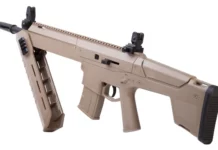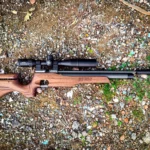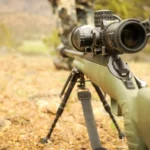There are an incredible number of broadheads on the market today, so choosing the best mechanical broadhead for your particular setup can be a daunting task.
My hope is that this article will help you narrow down your choices to a manageable number so that you can make a final decision based on your needs and the information at hand.
For hunting whitetail deer, our favorite is the G5 Deadmeat. If you prefer a more streamline 2-blade setup, then the Rage Hypodermic is going to be hard to beat.
If you’re looking specifically for a crossbow broadhead, we have a whole other article for that.
The G5 Deadmeat is our choice for the overall best mechanical broadhead. I am a big fan of G5 Outdoors and their American-made products.
The G5 checks all the boxes that make up a great expandable broadhead: it’s solid steel, features three blades with a 1 1/2-inch cutting diameter for maximum damage, and the Snap lock system keeps the blades in place to prevent pre-deployment.
The blades are rear-deploying, which we feel is a better design because they lose less energy during deployment, and the risk of deflection is less than with forward deploying blades.
In addition to its solid design, we like that the Deadmeat is offered in both 100 and 125 grains for those who may want a heavier setup. The three-pack of broadheads includes a Ballistic Match Point practice tip that matches the flight of the Deadmeat for easy practice without damaging your hunting broadheads.
If you want a solid expandable broadhead that hits hard and creates great blood trails, we highly recommend the G5 Deadmeat!
No one sells more broadheads annually than Rage, and I doubt any on the market kills more deer. That doesn’t necessarily mean they’re the best, but they have done a great job of marketing over the years.
Rage aren’t my favorite, but if I was going to shoot one it would be the standard two-blade Hypodermic.
The chisel tip, combined with the 2-inch cutting diameter should result in decent penetration, plenty of damage, and a short blood trail.
The rear deploying blades should minimize energy loss, and the improved shock collar technology ensures the blades stay in place until impact. We also like that this model Rage has a steel ferrule for maximum strength and durability.
The icing on the cake with these Rage broadheads is that you can often find them at a great price on Amazon. And despite what you may have heard, Rage broadheads are American-made.
I have personally used and killed deer with NAP Killzones. I really can’t say anything negative about them, other than I wished the long, tapered ferrule was steel rather than aluminum.
The Killzones are similar to the Rage discussed above in that they are rear deploying and feature a 2-inch cutting diameter.
What I like about the Killzone is that is features a spring clip design for blade deployment that eliminates the need for any rubber bands, clips or retainers. I also like the hardened trophy tip designed to split bone and get maximum penetration.
If you’re looking for a 2-blade mechanical broadhead with a decent cutting diameter, then the NAP Killzone may be the perfect option.
If it weren’t for the aluminum ferrule, we probably would have designated them as the Best Two Blade Mechanical Broadhead, but for now, the Rage Hypodermic gets that nod. You won’t go wrong with either, though.
While the G5 Deadmeat is our overall pick for best mechanical broadhead, their Megameat is a great option as well.
The Megameat features the same three-blade design, all steel construction, and Snap lock construction to keep the blades in place. The main difference is the larger 2-inch cutting diameter.
The reason we chose the Deadmeat over the Megameat is our belief that a 1.5-inch cutting diameter is ideal for a three-blade broadhead.
If you prefer a larger cutting diameter and have a bow setup that will give you a pass-thru every time, then the Megameat may be the perfect option for you. One thing is for sure, you can’t go wrong with a G5 product.
The Rage 2-Blade Chisel Tip is the second Rage expandable broadhead on our list, and the most popular option in the Rage’s extensive lineup of broadheads.
Like the Hypodermic, the Chisel Tip SC is 100 grain and features a 2-inch cutting diameter. The main difference is in the tip.
The Hypodermic has a longer, tapered tip that is part of the overall one-piece steel ferrule. The Chisel Tip has a unique, twisted chisel tip that is made for breaking through bone.
The reason we ranked this one below the Hypodermic is due to the weaker aluminum ferrule. Overall, though, this is still a great option.
Swhacker mechanical broadheads have a unique blade design with two separate cutting edges.
The smaller wing blades are designed to cut the hide and first set of ribs, with the idea that the main blades will still be razor-sharp once they deploy in the body cavity for maximum damage to internal organs.
In my mind, two weak points on the Swhacker are the aluminum ferrule and the rubber bands used to hold the blades closed in flight. However, I do like the fact that there is little chance of the blades not deploying due to the wing blade design.
And while they may not be my favorite broadhead, it’s hard to argue with a 4.7 out of 5 rating on Amazon. I also have mad respect for Levi Morgan as an archer and a bowhunter, and he is a big believer in Swhacker broadheads.
Table of Contents
Our Top 3
Pros and Cons of Expandable Broadheads
Choosing the Perfect Broadhead
All the broadheads discussed above are well known, highly rated, and should fly like your field points if your bow is properly tuned. You can’t go wrong with any of them.
I’ve shot all of them myself with good results, although I now prefer fixed blade broadheads for deer.
If you’re having a hard time narrowing down your choice among these options, here are the most important features to consider:
Broadhead Weight
Most mechanical broadheads are going to come in either 85, 100, 125 or 150 grains, with 100 grains being the most common. Any of these will work effectively. It’s really a matter of your overall arrow or bolt setup as to which weight you choose.
If you’re just going with a standard mid-weight arrow setup, then I’d recommend sticking with a 100 grain broadhead because they are readily available and will get the job done. However, if you’re like me and prefer a heavier arrow setup with a little higher FOC, then a 125 or even a 150 grain may be your best bet.
Even if you like a heavier setup, you can always use a 100 grain mechanical and add weight with a heavier brass insert or insert weight.
Two Blade vs Three Blade Broadheads
In your quest to find the perfect option, you may wonder if you should you shoot a two or three blade broadhead.
First off, let me say that either of those options will get the job done. Like most things in life, there’s tradeoffs to each option.
A two-blade broadhead is going to have less resistance, so it will be more likely to pass thru an animal. The tradeoff to that reduced resistance and increased penetration is less overall tissue damage and a smaller blood trail.
Three blade broadheads, on the other hand, should produce a larger wound channel and better blood trail. And while they will have more resistance than a two-blade, as long as you’re shooting a heavy enough arrow setup, and/or enough poundage on your bow, penetration shouldn’t be an issue.
Cutting Diameter
Cutting diameter is another important factor when choosing a broadhead. Similar to the blade number discussion above, cutting diameter will impact penetration and the subsequent blood trail.
A smaller cutting diameter will have less resistance and will be more likely to pass through, but it will also create a smaller wound channel. That smaller hole will me less overall tissue damage and a smaller blood trail.
That leaves you having to strike a balance between getting a solid pass-thru shot and still inflicting as much damage as possible for a good, short blood trail.
Other factors in that decision will be your bow setup and overall arrow setup. If you shoot a lower poundage, short draw length, or a light arrow setup, then you will want to err on the side of smaller cutting diameter to ensure a pass-thru shot.
My preference is a 1 1/2-inch to 2-inch maximum cutting diameter from a mechanical broadhead.
Final Thoughts
Choosing the best mechanical broadhead can be challenging. There are tons of options on the market today, and all of them will kill a deer with proper shot placement.
That’s not to say, however, that some options aren’t much better than others. To narrow down your choice, use the factors outlined above, and you should find one or more great options from our list above.
Ultimately, you won’t go wrong with any of the options listed above, but hopefully this article will help you find the best mechanical broadhead for your specific needs.











































